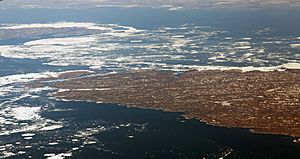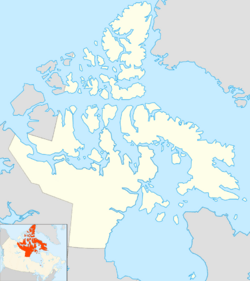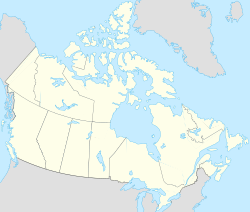Salisbury Island (Nunavut) facts for kids

Salisbury Island, Nunavut, June 25, 2014
|
|
| Geography | |
|---|---|
| Location | Hudson Strait |
| Coordinates | 63°35′N 77°00′W / 63.583°N 77.000°W |
| Area | 804 km2 (310 sq mi) |
| Coastline | 278 km (172.7 mi) |
| Administration | |
| Territory | Nunavut |
| Region | Qikiqtaaluk |
| Source: Salisbury Island at Atlas of Canada | |
Salisbury Island is a fascinating, uninhabited island found in the vast Arctic Archipelago of Canada. It is located in the Hudson Strait, which is a large body of water connecting the Hudson Bay with the Atlantic Ocean. This island is part of the Qikiqtaaluk Region in Nunavut, Canada's largest and northernmost territory. Salisbury Island covers an area of about 804 square kilometers (310 square miles), making it a significant piece of land in the Arctic wilderness.
Contents
Discovering Salisbury Island
Salisbury Island is a remote and wild place. Because it is uninhabited, it remains a natural habitat for many Arctic animals. The island's location in the Hudson Strait means it experiences very cold temperatures and long, dark winters. During the short Arctic summer, the sun shines almost all day, bringing a burst of life to the landscape.
Geography and Landscape
The island's landscape is typical of the Arctic. It features rocky shores, low-lying tundra, and perhaps some small hills. The land was shaped by ancient glaciers, which carved out valleys and left behind many lakes and ponds. The coastline stretches for about 278 kilometers (173 miles). This rugged environment is home to unique plants and animals that have adapted to the harsh Arctic conditions.
Climate and Weather
The climate on Salisbury Island is known as a polar climate. This means it has extremely cold winters and cool, short summers. Temperatures can drop far below freezing for many months. Even in summer, the average temperature might only be a few degrees above zero. The island also experiences strong winds and can be covered in snow and ice for much of the year. This makes it a challenging place for life, but many species thrive here.
Wildlife of the Arctic
Even though Salisbury Island has no people living on it, it is full of life! The Arctic environment supports a variety of animals that are specially adapted to the cold.
Marine Mammals
The waters around Salisbury Island are important for many marine mammals. You might find polar bears, which are excellent hunters on the ice. Seals, like ringed seals and bearded seals, are common and provide food for polar bears. Walruses also live in these waters, using their long tusks to find food on the seabed. In the deeper waters, beluga whales and bowhead whales migrate through the Hudson Strait.
Birds of the Island
During the summer months, Salisbury Island becomes a nesting ground for many types of birds. Migratory birds travel thousands of kilometers to breed in the Arctic, where there are fewer predators and plenty of insects. Birds like snow geese, eider ducks, and various gulls can be seen. Some birds, like the rock ptarmigan, stay on the island all year, changing their feather color to blend in with the snow in winter.
Arctic Plants
The plant life on Salisbury Island is mostly low-growing. The ground is often frozen just below the surface, a condition called permafrost. This means trees cannot grow tall. Instead, you'll find hardy plants like mosses, lichens, small shrubs, and Arctic wildflowers. These plants grow quickly during the short summer, taking advantage of the constant daylight. They provide food for smaller animals like Arctic hares and lemmings.
Human Connection to the Island
While Salisbury Island is uninhabited today, it has been known to people for a long time.
Early Explorers
European explorers began mapping the Arctic regions centuries ago. The Hudson Strait was an important route for ships trying to find the Northwest Passage, a sea route connecting the Atlantic and Pacific Oceans. These explorers would have charted islands like Salisbury Island as they navigated the challenging waters. The island likely gets its name from one of these early voyages or a person involved in Arctic exploration.
Indigenous Peoples
The Inuit people have lived in the Arctic for thousands of years. They have a deep knowledge of the land, sea, and animals. While Salisbury Island itself might not have permanent settlements, the Inuit would have traveled through the area for hunting and fishing. Their traditional knowledge is vital for understanding the Arctic environment.
Protecting the Arctic
Salisbury Island, like many other Arctic islands, is a valuable part of the world's natural heritage. Protecting these remote areas is important for the animals that live there and for the health of the planet. Scientists often study these uninhabited islands to learn more about climate change and its effects on the Arctic environment.
See also
 In Spanish: Isla Salisbury para niños
In Spanish: Isla Salisbury para niños
Images for kids




